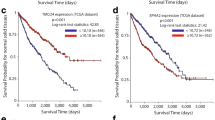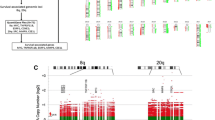Abstract
Many studies have examined DNA copy number changes or gene expression profiling and their association with clinical outcomes in breast cancer. However, until now no study has investigated whether acquired uniparental disomy (aUPD), in which both chromosomes in a pair are derived from the same parent, may have an association with clinical outcome including initiation and recurrence of breast cancer. In this study, we used high-density SNP and expression microarrays data from primary tumors of 313 lymph node-negative breast cancer patients who had not received adjuvant systemic therapy to evaluate the association of aUPD with metastasis-free survival (MFS) and overall survival (OS). In 55.9% (175/313) of the tumors, we defined aUPD, which was most frequent in the regions at chr17q (30.3%) and chr13q (19.4%). In Cox univariate regression analysis including all patients, aUPD at four regions at chr17q, ranging in size from 2.9 to 4.0 Mb, were associated with a poor OS. Only aUPD at one region, region B, on chr17q was associated with a poor MFS. Similarly, aUPD at two regions, A and B, on chr13q, with sizes of 3.5 and 3.1 Mb, were associated with a poor OS, but not with MFS. In ER-subgroup analyses, regions B and D at 17q were associated with poor MFS and OS in ER-negative patients. Various differentially expressed genes within the identified aUPD regions at chr17q were associated with MFS and OS in all patients (PPM1D, C17orf71, and TRIM37) and/or in the ER-negative patients (PPM1D, PPM1E, and SLCA3R1). We thus conclude that aUPD is a frequent event in breast cancer and that aUPD at specific regions in the genome has implications in this disease.



Similar content being viewed by others
Abbreviations
- aUPD:
-
Acquired uniparental disomy
- OS:
-
Overall survival
- MFS:
-
Metastasis-free survival
- ER:
-
Estrogen receptor
- SLC9A3R1 :
-
Na+/H+ exchanger regulatory factor 1 (also known as NHERF1)
- PPM1D :
-
Protein phosphatases, Mg+/Mn2+ dependent, 1D
- PPM1E :
-
Protein phosphatases, Mg+/Mn2+ dependent, 1E
References
Jonsson G, Staaf J, Vallon-Christersson J, Ringner M, Holm K, Hegardt C, Gunnarsson H, Fagerholm R, Strand C, Agnarsson BA et al (2010) Genomic subtypes of breast cancer identified by array-comparative genomic hybridization display distinct molecular and clinical characteristics. Breast Cancer Res 12(3):R42
Loo LW, Grove DI, Williams EM, Neal CL, Cousens LA, Schubert EL, Holcomb IN, Massa HF, Glogovac J, Li CI et al (2004) Array comparative genomic hybridization analysis of genomic alterations in breast cancer subtypes. Cancer Res 64(23):8541–8549
Tuna M, Smid M, Zhu D, Martens JW, Amos CI (2010) Association between acquired uniparental disomy and homozygous mutations and HER2/ER/PR status in breast cancer. PLoS One 5(11):e15094
Chin SF, Teschendorff AE, Marioni JC, Wang Y, Barbosa-Morais NL, Thorne NP, Costa JL, Pinder SE, van de Wiel MA, Green AR et al (2007) High-resolution aCGH and expression profiling identifies a novel genomic subtype of ER negative breast cancer. Genome Biol 8(10):R215
O’Shea D, O’Riain C, Gupta M, Waters R, Yang Y, Wrench D, Gribben J, Rosenwald A, Ott G, Rimsza LM et al (2009) Regions of acquired uniparental disomy at diagnosis of follicular lymphoma are associated with both overall survival and risk of transformation. Blood 113(10):2298–2301
Kato M, Sanada M, Kato I, Sato Y, Takita J, Takeuchi K, Niwa A, Chen Y, Nakazaki K, Nomoto J et al (2009) Frequent inactivation of A20 in B-cell lymphomas. Nature 459(7247):712–716
Gondek LP, Tiu R, O’Keefe CL, Sekeres MA, Theil KS, Maciejewski JP (2008) Chromosomal lesions and uniparental disomy detected by SNP arrays in MDS, MDS/MPD, and MDS-derived AML. Blood 111(3):1534–1542
Fitzgibbon J, Smith LL, Raghavan M, Smith ML, Debernardi S, Skoulakis S, Lillington D, Lister TA, Young BD (2005) Association between acquired uniparental disomy and homozygous gene mutation in acute myeloid leukemias. Cancer Res 65(20):9152–9154
Zhang Y, Martens JW, Yu JX, Jiang J, Sieuwerts AM, Smid M, Klijn JG, Wang Y, Foekens JA (2009) Copy number alterations that predict metastatic capability of human breast cancer. Cancer Res 69(9):3795–3801
McShane LM, Altman DG, Sauerbrei W, Taube SE, Gion M, Clark GM (2006) REporting recommendations for tumor MARKer prognostic studies (REMARK). Breast Cancer Res Treat 100(2):229–235
Smid M, Hoes M, Sieuwerts AM, Sleijfer S, Zhang Y, Wang Y, Foekens JA, Martens JW (2010) Patterns and incidence of chromosomal instability and their prognostic relevance in breast cancer subtypes. Breast Cancer Res Treat. doi:10.1007/s10549-010-1026-5
Wang Y, Klijn JG, Zhang Y, Sieuwerts AM, Look MP, Yang F, Talantov D, Timmermans M, Meijer-van Gelder ME, Yu J et al (2005) Gene-expression profiles to predict distant metastasis of lymph-node-negative primary breast cancer. Lancet 365(9460):671–679
Yamamoto G, Nannya Y, Kato M, Sanada M, Levine RL, Kawamata N, Hangaishi A, Kurokawa M, Chiba S, Gilliland DG et al (2007) Highly sensitive method for genomewide detection of allelic composition in nonpaired, primary tumor specimens by use of affymetrix single-nucleotide-polymorphism genotyping microarrays. Am J Hum Genet 81(1):114–126
Nannya Y, Sanada M, Nakazaki K, Hosoya N, Wang L, Hangaishi A, Kurokawa M, Chiba S, Bailey DK, Kennedy GC et al (2005) A robust algorithm for copy number detection using high-density oligonucleotide single nucleotide polymorphism genotyping arrays. Cancer Res 65(14):6071–6079
Fiscella M, Zhang H, Fan S, Sakaguchi K, Shen S, Mercer WE, Vande Woude GF, O’Connor PM, Appella E (1997) Wip1, a novel human protein phosphatase that is induced in response to ionizing radiation in a p53-dependent manner. Proc Natl Acad Sci USA 94(12):6048–6053
Rauta J, Alarmo EL, Kauraniemi P, Karhu R, Kuukasjarvi T, Kallioniemi A (2006) The serine-threonine protein phosphatase PPM1D is frequently activated through amplification in aggressive primary breast tumours. Breast Cancer Res Treat 95(3):257–263
Lu X, Ma O, Nguyen TA, Jones SN, Oren M, Donehower LA (2007) The Wip1 phosphatase acts as a gatekeeper in the p53-Mdm2 autoregulatory loop. Cancer Cell 12(4):342–354
Lu X, Nguyen TA, Zhang X, Donehower LA (2008) The Wip1 phosphatase and Mdm2: cracking the “Wip” on p53 stability. Cell Cycle 7(2):164–168
Koh CG, Tan EJ, Manser E, Lim L (2002) The p21-activated kinase PAK is negatively regulated by POPX1 and POPX2, a pair of serine/threonine phosphatases of the PP2C family. Curr Biol 12(4):317–321
Molina JR, Morales FC, Hayashi Y, Aldape KD, Georgescu MM (2010) Loss of PTEN binding adapter protein NHERF1 from plasma membrane in glioblastoma contributes to PTEN inactivation. Cancer Res 70(17):6697–6703
Hall RA, Premont RT, Chow CW, Blitzer JT, Pitcher JA, Claing A, Stoffel RH, Barak LS, Shenolikar S, Weinman EJ et al (1998) The beta2-adrenergic receptor interacts with the Na+/H+-exchanger regulatory factor to control Na+/H+ exchange. Nature 392(6676):626–630
Maudsley S, Zamah AM, Rahman N, Blitzer JT, Luttrell LM, Lefkowitz RJ, Hall RA (2000) Platelet-derived growth factor receptor association with Na(+)/H(+) exchanger regulatory factor potentiates receptor activity. Mol Cell Biol 20(22):8352–8363
Shibata T, Chuma M, Kokubu A, Sakamoto M, Hirohashi S (2003) EBP50, a beta-catenin-associating protein, enhances Wnt signaling and is over-expressed in hepatocellular carcinoma. Hepatology 38(1):178–186
Wheeler DS, Barrick SR, Grubisha MJ, Brufsky AM, Friedman PA, Romero G (2011) Direct interaction between NHERF1 and frizzled regulates beta-catenin signaling. Oncogene 30(1):32–42
Hwang JI, Heo K, Shin KJ, Kim E, Yun C, Ryu SH, Shin HS, Suh PG (2000) Regulation of phospholipase C-beta 3 activity by Na+/H+ exchanger regulatory factor 2. J Biol Chem 275(22):16632–16637
Hall RA, Spurney RF, Premont RT, Rahman N, Blitzer JT, Pitcher JA, Lefkowitz RJ (1999) G protein-coupled receptor kinase 6A phosphorylates the Na(+)/H(+) exchanger regulatory factor via a PDZ domain-mediated interaction. J Biol Chem 274(34):24328–24334
Dai JL, Wang L, Sahin AA, Broemeling LD, Schutte M, Pan Y (2004) NHERF (Na+/H+ exchanger regulatory factor) gene mutations in human breast cancer. Oncogene 23(53):8681–8687
Pan Y, Wang L, Dai JL (2006) Suppression of breast cancer cell growth by Na+/H+ exchanger regulatory factor 1 (NHERF1). Breast Cancer Res 8(6):R63
Song J, Bai J, Yang W, Gabrielson EW, Chan DW, Zhang Z (2007) Expression and clinicopathological significance of oestrogen-responsive ezrin-radixin-moesin-binding phosphoprotein 50 in breast cancer. Histopathology 51(1):40–53
Stemmer-Rachamimov AO, Wiederhold T, Nielsen GP, James M, Pinney-Michalowski D, Roy JE, Cohen WA, Ramesh V, Louis DN (2001) NHE-RF, a merlin-interacting protein, is primarily expressed in luminal epithelia, proliferative endometrium, and estrogen receptor-positive breast carcinomas. Am J Pathol 158(1):57–62
Karn T, Ruckhaberle E, Hanker L, Muller V, Schmidt M, Solbach C, Gatje R, Gehrmann M, Holtrich U, Kaufmann M et al (2011) Gene expression profiling of luminal B breast cancers reveals NHERF1 as a new marker of endocrine resistance. Breast Cancer Res Treat. doi:10.1007/s10549-010-1333-x
Al-Kuraya K, Schraml P, Torhorst J, Tapia C, Zaharieva B, Novotny H, Spichtin H, Maurer R, Mirlacher M, Kochli O et al (2004) Prognostic relevance of gene amplifications and coamplifications in breast cancer. Cancer Res 64(23):8534–8540
Rennstam K, Ahlstedt-Soini M, Baldetorp B, Bendahl PO, Borg A, Karhu R, Tanner M, Tirkkonen M, Isola J (2003) Patterns of chromosomal imbalances defines subgroups of breast cancer with distinct clinical features and prognosis. A study of 305 tumors by comparative genomic hybridization. Cancer Res 63(24):8861–8868
Tanner MM, Tirkkonen M, Kallioniemi A, Holli K, Collins C, Kowbel D, Gray JW, Kallioniemi OP, Isola J (1995) Amplification of chromosomal region 20q13 in invasive breast cancer: prognostic implications. Clin Cancer Res 1(12):1455–1461
Hu X, Stern HM, Ge L, O’Brien C, Haydu L, Honchell CD, Haverty PM, Peters BA, Wu TD, Amler LC et al (2009) Genetic alterations and oncogenic pathways associated with breast cancer subtypes. Mol Cancer Res 7(4):511–522
Chin K, DeVries S, Fridlyand J, Spellman PT, Roydasgupta R, Kuo WL, Lapuk A, Neve RM, Qian Z, Ryder T et al (2006) Genomic and transcriptional aberrations linked to breast cancer pathophysiologies. Cancer Cell 10(6):529–541
Carter SL, Eklund AC, Kohane IS, Harris LN, Szallasi Z (2006) A signature of chromosomal instability inferred from gene expression profiles predicts clinical outcome in multiple human cancers. Nat Genet 38(9):1043–1048
Perou CM, Sorlie T, Eisen MB, van de Rijn M, Jeffrey SS, Rees CA, Pollack JR, Ross DT, Johnsen H, Akslen LA et al (2000) Molecular portraits of human breast tumours. Nature 406(6797):747–752
van de Vijver MJ, He YD, van’t Veer LJ, Dai H, Hart AA, Voskuil DW, Schreiber GJ, Peterse JL, Roberts C, Marton MJ et al (2002) A gene-expression signature as a predictor of survival in breast cancer. N Engl J Med 347(25):1999–2009
Acknowledgments
We thank Casey Gates for excellent technical assistance and Diana Hacket for editing the manuscript.
Conflict of interest
The authors declare no conflict of interest.
Author information
Authors and Affiliations
Corresponding author
Electronic supplementary material
Below is the link to the electronic supplementary material.
10549_2011_1579_MOESM2_ESM.ppt
Supplementary Fig. 2. Overall survival analysis of all 313 breast cancer patients as a function of aUPD regions at chr 17q and chr 13q. (a) 17qA, (b) 17qB, (c) 17qC, (d) 17qD, (e) 13qA, (f) 13qB. Patients at risk at various time points are indicated. (PPT 165 kb)
Rights and permissions
About this article
Cite this article
Tuna, M., Smid, M., Martens, J.W.M. et al. Prognostic value of acquired uniparental disomy (aUPD) in primary breast cancer. Breast Cancer Res Treat 132, 189–196 (2012). https://doi.org/10.1007/s10549-011-1579-y
Received:
Accepted:
Published:
Issue Date:
DOI: https://doi.org/10.1007/s10549-011-1579-y




